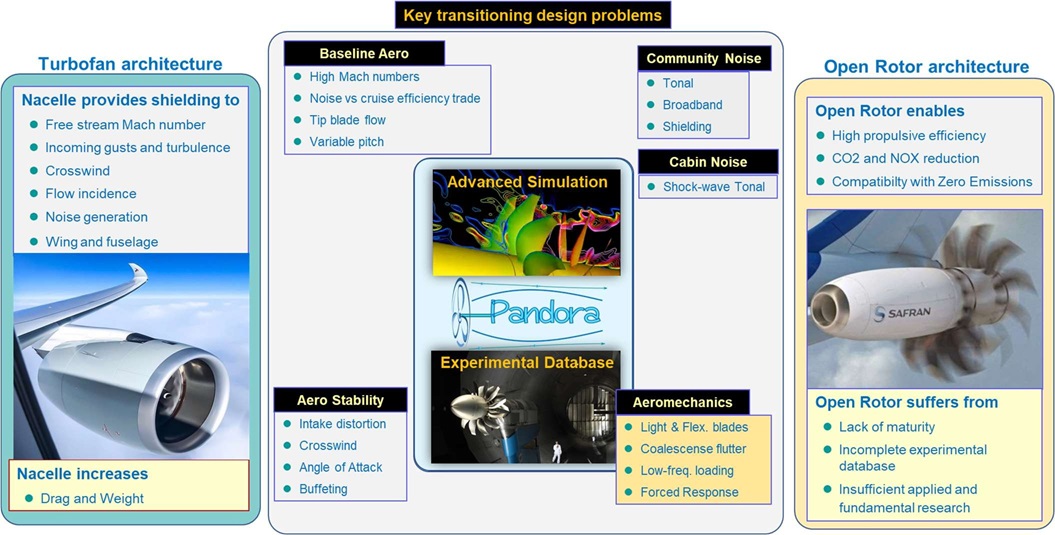The PANDORA project stands at the cusp of a significant transformation in aviation technology. As we explore the transition from the conventional turbofan architecture to the innovative open rotor design, we delve into a realm of aviation that promises unprecedented efficiencies and a substantial reduction in environmental impact. This journey, however, is not without its challenges
Turbofan Architecture: A Shielded Past
The turbofan engine, a staple of modern aircraft, owes much of its success to the nacelle. This crucial component shields the engine from various external factors such as free stream Mach number, incoming gusts, turbulence, and crosswind, while also significantly impacting the aircraft’s noise signature and flow incidence. Moreover, the nacelle plays a protective role for critical components such as the wing and fuselage. Yet, this shielding comes at a cost, increasing the engine’s drag and weight, thus impacting its overall efficiency

Role and concept of the PANDORA project. Key aspects for transitioning from ducted to open fans.
The open rotor engine emerges as a beacon of efficiency in this context. By eliminating the nacelle, open rotors offer high propulsive efficiency and stand as a testament to aviation’s potential for CO2 and NOx reduction. This design aligns perfectly with the industry’s ambitious zero-emissions goals. However, the path to integrating open rotor engines into mainstream aviation is paved with obstacles, including their current lack of maturity, an incomplete experimental database, and a need for more comprehensive applied and fundamental research.
Navigating the Transition: Design Challenges Ahead
The transition to open rotor architecture necessitates overcoming several key design challenges:
- Baseline Aero: High Mach numbers and the trade-off between noise and cruise efficiency, alongside managing tip blade flow and variable pitch, are paramount.
- Aero Stability: Factors such as intake distortion, crosswind, angle of attack, and buffeting must be meticulously managed to ensure stability.
- Community Noise: The elimination of the nacelle raises concerns over tonal and broadband noise, challenging designers to find new methods of shielding.
- Cabin Noise: Without the nacelle, managing shock-wave tonal noise becomes a critical concern for passenger comfort.
- Aeromechanics: The design of light and flexible blades, coupled with the need to address coalescence flutter, low-frequency loading, and forced response, requires innovative solutions.
The PANDORA Promise
The PANDORA project is not just about overcoming these challenges; it’s about reimagining the future of aviation. By addressing these key transitioning design problems, we aim to unlock the full potential of open rotor technology. Our vision is clear: to pave the way for aircraft that are not only more efficient but also compatible with the global imperative for sustainability.
Through the PANDORA project, we are setting the foundation for a new era in aviation, where open rotor engines redefine what is possible. We invite the global community—researchers, engineers, and enthusiasts alike—to join us on this exciting journey towards a greener, more efficient future in the skies.